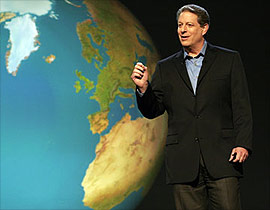
| HOME |
| NERVE |
| REVIEWS |
| ARCHIVE |
| EVENTS |
| LINKS |
| ABOUT US |
| CONTRIBUTORS |
| BACK ISSUES |
| CONTACT US |
 An
Inconvenient Truth (U)
An
Inconvenient Truth (U)
Directed by Davis Guggenheim
On general release from 15th September 2006
Reviewed by Adam Ford
When reviewing any new film, critics normally look back at important moments from the star’s career. I don’t see why a documentary about climate chaos should be any different.
Al Gore hasn’t been in many films, but between 1992 and 2000 he was arguably the second most powerful man in the world, serving as Vice President of the United States under Bill Clinton. Since Gore tells us that the US is the world’s biggest culprit in polluting the atmosphere with carbon dioxide, did carbon dioxide emissions go down during the 1990s? No, they reached the highest ever level. The US signed up to the Kyoto treaty – which agreed to cut emissions by 5% over a decade. But this was a far smaller reduction than scientists said was needed, and even then the Clinton administration tried to find sneaky ways around it. Clinton/Gore also refused to demand that American car companies made their products more fuel efficient, and subjected Iraq to a long bombing and sanctions campaign that paved the way for an oil war both later supported, only disputing timing and tactics.
So it is an inconvenient truth that out of the six billion people in the world, Al Gore’s record makes him one of the worst possible candidates to ‘star’ in a film about how we can deal with the massive problems that massive carbon emissions are creating. Possibly, just possibly, George W Bush would be worse. But that is no recommendation for anything.
Gore’s film consists of a slide show lecture he gave to a small audience, cartoon graphics and occasional bits of film from various locations around the world. He throws far too many statistics at the viewer in far too short a time, and many will probably feel more confused about the issues at the end than they did at the beginning.
However, it boils down to this. Since the industrial revolution, humanity has put ever-greater amounts of carbon dioxide into the air. This then prevents rays of sunlight reflecting back into space. Instead, they raise the temperature of the planet. This leads to lethal heatwaves, more hurricanes (like Katrina), and the steady melting of ice at the north and south poles. Sea levels are going to rise dramatically, causing floods all over the world. The World Trade Center memorial will be under water, as will the Netherlands and many costal regions. There will be millions of refugees. The more carbon dioxide we put in the atmosphere now, the worse the future will be.
So what should we do about it? According to Gore there are two things moviegoers can do. The first is to put pressure on their political representatives, presumably by writing letters or visiting surgeries. But anyone who’s ever tried that knows that knows what a waste of time it is. The second thing he wants us to do is buy things like environmentally friendly lightbulbs. No doubt that could makes a difference, but only a small one in the scheme of things.
The only way ordinary people can actually make a big difference is by uniting globally to fight this global problem. Whatever politicians say when they are out of office, they cannot stop environmental destruction once they get into office. This is because governments run the economy of an individual state, region, whatever. An elected official who is good at his or her job cannot do anything that limits profit making and business in the area they control.
To save the world from catastrophe, we need to radically restructure our society, putting the needs of the environment and those six billion before the interests of rich people’s bank accounts. Politicians could never vote for that.
For Al Gore’s tips on energy efficiency, visit www.climatecrisis.net. For an alternative strategy, visit www.climatecamp.org.uk